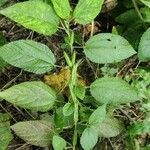Herbs annual, to 1 m tall. Stem red-brown, slightly yellowish puberulent; branches slender. Petiole 0.9-1.6 cm, with yellowish, long, rigid hairs; leaf blade ovate or broadly ovate, 4.5-6.5 × 3-4 cm, sparsely pilose on both surfaces, glabrescent, basal veins 5-7, lateral veins 3-6 pairs, base rounded, margin serrate, basal pair of teeth usually elongating into filiform or caudate appendages, apex shortly acuminate or acute. Flowers solitary or several together in cymes, axillary or leaf-opposed; peduncle and pedicel very short or absent. Sepals 5, purple-red abaxially, narrowly oblong, ca. 5 mm, semi-foveolately boat-shaped distally, apex awned. Petals 5, yellow, nearly as long as sepals, obovate. Stamens many, yellow, ca. 3 mm. Ovary 3-5-loculed, long cylindrical, puberulent; style rodlike; stigma beaklike, 5-toothed. Capsule cylindrical, angled, 3-5-valved, 1.2-2.5 × ca. 0.5 cm, apex 3-5-angled, awns bifurcate. Seeds separated by transverse septum. Fl. summer-autumn.
Plants herbs, annual or short-lived perennial. Stems erect to decumbent or ascending, 2–13(–20) dm, puberulent in lines, hairs simple, arched, downturned to irregularly oriented. Leaves: petiole 5–30(–36) mm; blade ovate or broadly ovate to ovate-elliptic, 2–8 cm, base rounded-truncate, margins serrate, one or both of basal pair of teeth sometimes prolonged into caudate-setaceous point 3–5 mm, apex short-acuminate or acute, surfaces sparsely pilose to strigose on veins and lamina. Inflorescences usually solitary flowers, sometimes fasciculate or cymose, 2–3-flowered. Pedicels 2–3 mm. Flowers: sepals narrowly oblong, 3–5 mm, awned, glabrous; petals 4–6 mm; stamens 10–20. Capsules cylindric, wing-angled, wings to 2 mm wide, 3(–4)[–5]-valved, each valve terminated by bifurcate awn 1.5–3 mm, 15–25(–40) × 4–5 mm, glabrous. 2n = 14.
A herb which grows 40-80 cm tall. It spreads over the ground. The stems are reddish and densely hairy. The leaves are sword shaped or oval, and taper towards the tip. The leaf blade is 3-8 cm long by 2-5 cm wide. They are dark green and have teeth around the edge. Often the lowest tooth, near the base of the leaf, is elongated into a bristle. The leaf stalk is 1-4 cm long. The flowers are yellow, and in pairs opposite the leaves. The fruit is a thin capsule 18-30 mm long. It has 2-5 valves and wings along the edge.
Leaf-lamina 2–8 × 1–3·5 cm., ovate, narrowly ovate or broadly elliptic, acute or subacute at the apex, margin serrate-crenate, rounded at the base, usually with two basal setaceous appendages, sparsely pilose on both surfaces, especially on the nerves; petiole up to 3 cm. long, pilose, more densely so on the upper side; stipules up to 1 cm. long, setaceous, sparsely setulose.
Capsule up to 4 cm. long, usually straight, erect, 3–5-sided with narrow membranous wings on the angles, glabrous, terminating in 3–5 spreading horns 1·5–3 mm. long; horns entire or sometimes bifid; valves only shallowly hollowed out to contain the seeds on the inner surface.
Inflorescences of 1–3-flowered cymes, opposite the upper leaves; peduncles very short or obsolete, up to 1 mm. long, pubescent; pedicels similar, c. 1 mm. long; bracts up to 3 mm. long, setaceous, sparsely setulose-pubescent.
Branching annual up to 50 cm. tall; first branches more or less erect, the later ones tending to be prostrate; branches pilose, usually more densely so on one side, compressed at first, later cylindric.
Petals yellow, the same length as the sepals, narrowly obovate, slightly undulate at the rounded apex, with a very short ciliate basal claw 0·5 mm. long.
Sepals c. 4 mm. long, linear, somewhat hooded and caudate-acuminate at the apex, glabrous.
Ovary 3–5-angled, cylindric, puberulous; style c. 1 mm. long, glabrous.
Seeds c. 0·8 × 0·8 mm., numerous, shortly cylindric, brown.
Annual or perennial, branched, erect or prostrate
Androgynophore and annulus 0·3 mm. long.
Flowers golden-yellow.
Stamens c. 10.






